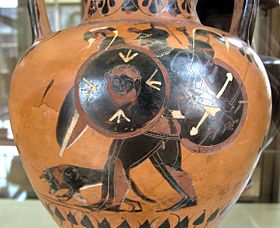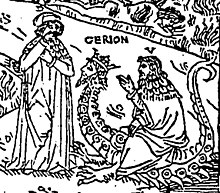Geryon
In Greek mythology, Geryon (Γηρυών / Gēryṓn), Geriones (Γηρυόνης / Gēryónēs), Gerioneas (Γηρυονέας / Gēryonéas) or Gerioneo (Γηρυονεύς / Gēryónéús) is a giant son of Chrysaor and Callirroe.
Gerion is described as a singular anthropomorphic being made up of three giant human bodies, with their respective heads and limbs, according to most versions. Although the exact form of the union between the three bodies is not specified, he is usually represented united by the torsos, like three united men.
Gerion lived on the Eritea island of the Gadeiras archipelago (present-day Cádiz), beyond the Pillars of Hercules to the west of the Mediterranean, already in the course of the Ocean. He owned a dog named Ortro, and a splendid herd of cattle that was guarded by Ortro and a shepherd named Eurytion.
As the tenth of his twelve labors, Heracles—Hercules in Roman mythology—robbed him of his herd of red oxen and cows. Geryon went in search of revenge and fought against Heracles, but he shot an arrow at him, poisoned with the blood of the Hydra, which pierced all three of his bodies and finished him off.
The Tenth Labor of Heracles
Heracles' tenth labor consisted of stealing Geryon's cattle. While traveling there, he crossed the Libyan desert (Libya was the generic name for Africa to the Greeks) and became so frustrated by the heat that he shot an arrow at Helios, the sun. Helios begged him to stop and Heracles asked in exchange for the golden cup that the god used to cross the sea every night from west to east. Heracles used this golden cup to reach Erythia, in what is one of the motifs of the vase painters.
Origin
When the sun reaches the constellation Gemini, it meets the constellation Auriga. Many ancient beliefs associated the sun's daily path across the sky with the sun god driving a fiery chariot, and thus, here, the sun's annual path (its transit) gets its chariot (Charioteer). Later Greek mythology considered that the sun used a cup to cross the sky.
In this region of the sky there is also a vast space without easily visible stars (now occupied by the modern constellations Lynx and Camelopardalis), which the ancient Greeks described as a desert. A story based on this region of the sky therefore requires a vast desert, the best known to the ancient Greeks being that of Libya. However, as this desert area is far from many constellations in this region of the sky, setting a story in it required someone to cross it to its main location. Since the Charioteer is the closest constellation from the beginning of the sun's transit to the edge of empty space, a sun chariot (later converted to a cup) becomes the way to cross the desert.
The Milky Way was so named by the ancient Greeks because it appears to be a patch of milk stretching across the sky. Some, however, were able to discern individual stars in it, and in this way it came to resemble a vast herd of cows, their milk filling the gaps between them. The Capella star, which is part of the Charioteer, was known to the Greeks as the "shepherd's star" (as some considered the Charioteer to be a shepherd driving a chariot, including this one, while carrying a goat slung over his left shoulder).. Capella is very close, even if outside, to the Milky Way and as such, considered as a shepherd, seems to be herding it.
In Gemini, the constellation Canis Major (the "big dog") lies close to the Milky Way. The head of the constellation faces away from the sun. However, at the other end of the constellation (where the tail would be) is the star Sirius, considered evil by many ancient mythologies due to its twinkle and redness, which was considered a dog ("dog star"), by association with the constellation Thus, the constellation had two heads, one the normal one and another, Sirius, at the other end.
Closer to the sun than Canis Major, and also guarding the Milky Way in this zone of its transit in a similar way to Canis Mayor and Capella, is Orion the giant. Orion is traditionally considered a single giant, but it is equally possible to distinguish in it three separate complete bodies joined at the waist, as Geryon was described, particularly as the legs appear in quite different directions, and alternate constellation drawings (which have in counts slightly fainter stars than basic diagrams) usually show three rather than two arms, the second and third sharing the same right shoulder.
The sun manages to overcome these obstacles, crossing the Milky Way. The Charioteer seems to have been left in the Milky Way itself, and for this reason some of the cows in the herd are in it. After the Milky Way, the sun meets Gemini. The representations of Gemini vary according to whether he leans to the east or west, being possible in the latter case to draw the constellation as two men, resting their feet on the Milky Way. In the representations that tilt it to the east, one of the twins is in the Milky Way and the other is outside it, and thus one has "stolen some cows" and the other, the one that crosses the transit of the sun, has not. In the myth of Castor and Pollux (the names usually given to the twins), their deaths are due to a dispute over cattle theft.
Cthonic associations
Geryon is sometimes identified as a chthonic death demon, primarily because of its association with the far west direction. In Dante's Divine Comedy, Geryon becomes a beast with the tail of a scorpion but the face of an honest man who dwells in Phlegethon on the edge of the seventh circle (the circle of violence) descending into hell. There he points the way to the eighth circle as he bathes on the edge of the abyss in the Cocytus.
Later Legends
According to some authors, the giant uprooted an olive tree to use as a weapon against Heracles. The tree shattered as it smashed against the hero's bronze breastplate, which he countered with the same weapon. The giant's powerful hands came together to stop the clash and in this way he disarmed Heracles, who fled running for cover in a forest.
Geryon, after convincing his mother (who had witnessed the whole event) that she should capture Heracles, flew over the area looking for him. Heracles then took the opportunity to shoot one of his poisoned arrows, which hit the giant through his three hearts. He fell to the ground and a strawberry tree was born from the blood that emanated from his wound, others say that a dragon tree and another legend identifies the dragon tree that is preserved in the garden of the Faculty of Fine Arts in Cádiz with the one that emerged from the blood of Gerión.
According to the History of Spain by Alfonso X the Wise, written in the 13th century, Gerión forced his subjects to give him half of their goods, and even their children, until Hercules arrived in these lands. The terrified townspeople pleaded for his help, and he challenged Geryon to a fight to the death. After three days of battle, the giant's head was buried in the same place where the Tower of Hercules was built in La Coruña.
In the first attempt to give Geryon historical validity, Pompeyo Trogus, known from the epitome that Marcus Juniano Justin made of his work, affirms that Geryon was not a giant with three bodies, but rather three brothers, who attacked Hercules when they saw him stealing their cattle:
The same Gerion was not a man with three bodies, as the fables tell us, but it was three brothers who lived in such harmony, who seemed to act moved by one soul; and they did not attack Hercules. motu proprioSeeing to steal their reses, they tried to recover what had been taken from them by force.
Geryon also appears in Canto XVII of Dante Alighieri's Divine Comedy, and is described as a beast with a human face and the body of a serpent, two claws up to the armpit, and a scorpion-like tail. Gustave Doré captures it in his engravings on the work.
Contenido relacionado
Urban II
Yachar
Church of rome




